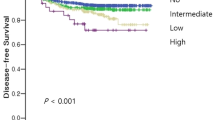Abstract
Background
The diagnostic impact of lymphovascular invasion (LVI), perineural invasion (PNI), and tumor budding in stage I colon cancer is currently unknown. This study was conducted to evaluate the prognostic impact of LVI, PNI, and tumor budding in stage I colon cancer.
Methods
From January 2008 to December 2013, 720 patients who underwent curative surgery and were diagnosed with stage I colon cancer were reviewed retrospectively. These patients were categorized into two groups based on LVI, PNI, and tumor budding: the no risk group (n = 566) and risk group (n = 154).
Results
Median follow-up period was 103.5 months, and the 5-year disease-free survival rate of the risk group was significantly lower than that of the no risk group (p = 0.025). In multivariate analysis, only the risk group had prognostic factors for 5-year disease-free survival (p = 0.036). In addition, only differentiation was an independent predictor in the risk group (p = 0.009).
Conclusion
LVI, PNI, and tumor budding are strong prognostic factors for stage I colon cancer. Therefore, patients with positive LVI, PNI, or tumor budding should receive close follow-up and potentially be considered for chemotherapy.

Similar content being viewed by others
Change history
04 April 2020
The name of the author of the original published version of this article was presented incorrectly. The author name <Emphasis Type="Bold">“JungWook Huh”</Emphasis> should have been presented as <Emphasis Type="Bold">“Jung Wook Huh”.</Emphasis>
References
Huh JW, Kim HR, Kim YJ (2010) Lymphovascular or perineural invasion may predict lymph node metastasis in patients with T1 and T2 colorectal cancer. J Gastrointest Surg 14:1074–1080
Harris EI, Lewin DN, Wang HL, Lauwers GY, Srivastava A, Shyr Y, Shakhtour B, Revetta F, Washington MK (2008) Lymphovascular invasion in colorectal cancer: an interobserver variability study. Am J Surg Pathol 32:1816–1821
Yuan H, Dong Q, Zheng B, Hu X, Xu JB, Tu S (2017) Lymphovascular invasion is a high risk factor for stage I/II colorectal cancer: a systematic review and meta-analysis. Oncotarget 8:46565–46579
Lim SB, Yu CS, Jang SJ, Kim TW, Kim JH, Kim JC (2010) Prognostic significance of lymphovascular invasion in sporadic colorectal cancer. Dis Colon Rectum 53:377–384
Batsakis JG (1985) Nerves and neurotropic carcinomas. Ann Otol Rhinol Laryngol 94:426–427
Knijn N, Mogk SC, Teerenstra S, Simmer F, Nagtegaal ID (2016) Perineural invasion is a strong prognostic factor in colorectal cancer: a systematic review. Am J Surg Pathol 40:103–112
Liebig C, Ayala G, Wilks J, Verstovsek G, Liu H, Agarwal N, Berger DH, Albo D (2009) Perineural invasion is an independent predictor of outcome in colorectal cancer. J Clin Oncol 27:5131–5137
Prall F, Nizze H, Barten M (2005) Tumour budding as prognostic factor in stage I/II colorectal carcinoma. Histopathology 47:17–24
Mitrovic B, Schaeffer DF, Riddell RH, Kirsch R (2012) Tumor budding in colorectal carcinoma: time to take notice. Mod Pathol 25:1315–1325
Ribeiro MS, Wallace MB (2015) Endoscopic treatment of early cancer of the colon. Gastroenterol Hepatol (N Y) 11:445–452
Koelzer VH, Zlobec I, Lugli A (2016) Tumor budding in colorectal cancer--ready for diagnostic practice? Hum Pathol 47:4–19
Chok KS, Law WL (2007) Prognostic factors affecting survival and recurrence of patients with pT1 and pT2 colorectal cancer. World J Surg 31:1485–1490
Betge J, Langner C (2011) Vascular invasion, perineural invasion, and tumour budding: predictors of outcome in colorectal cancer. Acta Gastroenterol Belg 74:516–529
Hase K, Shatney C, Johnson D, Trollope M, Vierra M (1993) Prognostic value of tumor “budding” in patients with colorectal cancer. Dis Colon Rectum 36:627–635
Sirin AH, Sokmen S, Unlu SM, Ellidokuz H, Sarioglu S (2019) The prognostic value of tumor budding in patients who had surgery for rectal cancer with and without neoadjuvant therapy. Tech Coloproctol 23:333–342
Graham RP, Vierkant RA, Tillmans LS, Wang AH, Laird PW, Weisenberger DJ, Lynch CF, French AJ, Slager SL, Raissian Y, Garcia JJ, Kerr SE, Lee HE, Thibodeau SN, Cerhan JR, Limburg PJ, Smyrk TC (2015) Tumor budding in colorectal carcinoma: confirmation of prognostic significance and histologic cutoff in a population-based cohort. Am J Surg Pathol 39:1340–1346
Lugli A, Karamitopoulou E, Zlobec I (2012) Tumour budding: a promising parameter in colorectal cancer. Br J Cancer 106:1713–1717
van Wyk HC, Park J, Roxburgh C, Horgan P, Foulis A, McMillan DC (2015) The role of tumour budding in predicting survival in patients with primary operable colorectal cancer: a systematic review. Cancer Treat Rev 41:151–159
Prall F (2007) Tumour budding in colorectal carcinoma. Histopathology 50:151–162
Betge J, Kornprat P, Pollheimer MJ, Lindtner RA, Schlemmer A, Rehak P, Vieth M, Langner C (2012) Tumor budding is an independent predictor of outcome in AJCC/UICC stage II colorectal cancer. Ann Surg Oncol 19:3706–3712
Huh JW, Lee JH, Kim HR, Kim YJ (2013) Prognostic significance of lymphovascular or perineural invasion in patients with locally advanced colorectal cancer. Am J Surg 206:758–763
Author information
Authors and Affiliations
Contributions
Data collection and writing of manuscript are attributed to Seijong Kim. Study proposal, design, analysis, and responsibility to correspondence are attributed to Jung Wook Huh. All authors contributed to the enrollment of patients and approved the final version of the manuscript.
Corresponding author
Ethics declarations
The study was approved by the Institutional Review Board of Samsung Medical Center.
Conflict of interest
The authors declare that they have no conflict of interest.
Additional information
Publisher’s note
Springer Nature remains neutral with regard to jurisdictional claims in published maps and institutional affiliations.
The original version of this article was revised: The name of the author of the original published version of this article was presented incorrectly. The author name “JungWook Huh” should have been presented as “Jung Wook Huh”. This has been correctly presented above.
Rights and permissions
About this article
Cite this article
Kim, S., Huh, J.W., Lee, W.Y. et al. Lymphovascular invasion, perineural invasion, and tumor budding are prognostic factors for stage I colon cancer recurrence. Int J Colorectal Dis 35, 881–885 (2020). https://doi.org/10.1007/s00384-020-03548-4
Accepted:
Published:
Issue Date:
DOI: https://doi.org/10.1007/s00384-020-03548-4




